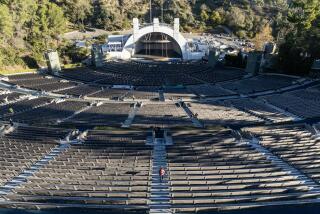Bowl Reveals Tempo Changes
Willem Wijnbergen, managing director of the Los Angeles Philharmonic, unveiled on Tuesday a “more relevant” lineup for the 1999 Hollywood Bowl season beginning in June. After an 8% drop in Bowl attendance from 1997 to 1998 and years of inattention, he explained, the program was in need of an overhaul.
Wijnbergen, along with Hollywood Bowl Orchestra principal conductor John Mauceri and three newly hired lieutenants, announced new jazz and world music series replacing the Virtuoso recitals and the Hollywood Bowl Orchestra’s Sunday classical programming. The Los Angeles Philharmonic’s Tuesday and Thursday night concerts, with Esa-Pekka Salonen and guest conductors, remains in place. The Bowl orchestra will continue to offer broadly defined pops programs on Fridays and Saturdays, many with the Bowl’s signature fireworks.
“We’ve taken the Hollywood Bowl for granted in the last 10 years,” Wijnbergen said of the venue, whose profits help subsidize the rest of the Philharmonic operation. “It’s a very important part of our lives that needs to be nurtured. The only way to revitalize it is to invest in quality programming and people with specific expertise who can help us.”
One of those experts is John Clayton, whose Clayton-Hamilton Jazz Orchestra will be the “house band” of the Bowl. Awarded a multiyear contract as the Bowl’s artistic director of jazz, the bassist will play at and write original music for eight Wednesday night jazz evenings--up from five this year.
Preseason Concerts Are Planned
To generate interest in the series, beginning in January, Clayton and company will perform preseason concerts in areas including South-Central, San Pedro, East Los Angeles and the Valley. During the summer, artists such as Ray Brown, Dr. John, Dee Dee Bridgewater and Diana Krall are scheduled to perform.
“Jazz is the ultimate American art form,” said Wijnbergen, who begins his second year as head of the Philharmonic in March. “It’s never been a mass medium but then, it’s never been given a chance. We’re bringing it center-stage, providing the glamour it deserves.”
Clayton promises a one-of-a-kind experience. “We want to make every concert tailor-made,” Clayton says. “We’re not going to invite a Krall or a Bridgewater and have them just do their thing. We will incorporate what they do with our orchestra.”
Another specialist who has been brought on board is Tom Schnabel, host of KCRW’s “Cafe LA” who has been appointed program director of world music for the Bowl. The new family-oriented Sunday night series will feature work by musicians popular in their countries who have yet to ignite in the American market. Among the offerings: Brazilian fare with Gilberto Gil, a Tango Night with Juan Jose Mosalini, a Gypsy-flamenco program, and an American roots concert featuring blues singer Lonnie Brooks and the Lakota Sioux Dance Theatre.
“This series will be fun and accessible, and should draw a lot of ethnic families. We gave up our Sunday classics series and the Virtuoso series, which had been dwindling,” says general manager of summer programming Lindsey Nelson, who took over the creative end of general manager Anne Parsons’ job when she left earlier this year.
Now-Defunct Series Had Attendance Losses
Attendance figures bear him out. Average per concert sales for 1998 were 10,500 for the 18,000-seat venue, down from 11,500 the year before. Though Friday and Saturday pops concerts were up a percentage point, the two now-defunct series were particularly hard hit. Sunday classics drew about 5,000 people each, compared to 10,000 for more pops-oriented Sunday programs in 1997. Wednesday night Virtuoso concerts sold an average 3,500 tickets compared with 4,497 in 1997.
Still, Wijnbergen said there would be no increase in pop and rock programming in order to fill the seats. “Our goal is artistic quality and depth--not just creating music for the millions squared,” he said. “Outside producers will continue to do six to 10 rock and pop concerts a year, but we won’t be doing our own.”
Tuesdays and Thursdays will still feature the L.A. Philharmonic, with the addition of Mikhail Pletnev’s Russian National Orchestra in a weeklong residency. The Tuesday programs are described as “Musical Travels” and “Musical Tales” and include a splashy Peter Sellars-Bill Viola collaboration and soprano Dawn Upshaw singing Ravel’s “Sheherazade.” Thursday nights will be more traditional, featuring five violin concertos and all five Beethoven piano concertos. Philharmonic music director Esa-Pekka Salonen plans to conduct three weeks next season, up from two this year.
The Hollywood Bowl Orchestra this season will be focusing almost exclusively on pops, which Wijnbergen hopes will further the “romantic tradition of the Bowl.” Mauceri defines the genre in broad terms: “I never play a series of short little tunes that usually constitute pops. My concerts are journeys that include a vast variety of music.”
Programs include a Bastille Day at the Bowl with Michel Legrand, one of Mauceri’s trademark “Movie Nights,” “100 Years of Broadway” and a celebration of the 50th anniversary of the musical “South Pacific.” The Friday-Saturday repertory will also feature composer-conductors John Williams and Jerry Goldsmith leading the Los Angeles Philharmonic. And Mauceri and the Bowl orchestra will close the summer season with a “Farewell to the 20th Century” gala, playing favorites from the last 100 years, with input from users of America Online. Wijnbergen’s newcomer status, and the tenor of the town, helped the managing director in rethinking the Bowl: “You can look at things more rationally when you have no history and baggage,” he said. “And L.A. is more open-minded toward ideas in general.
“Besides,” Wijnbergen adds, “the whole organization realized that changes had to be made. The Bowl has to speak out to all of L.A.”
*
Freelance writer Don Heckman contributed to this story.
More to Read
The biggest entertainment stories
Get our big stories about Hollywood, film, television, music, arts, culture and more right in your inbox as soon as they publish.
You may occasionally receive promotional content from the Los Angeles Times.










